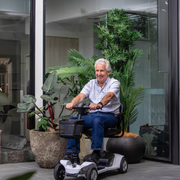- Home
- /
- Buyer's Guides
- /
- Buyer’s Guide To Bariatric Equipment

Buyer’s Guide To Bariatric Equipment
02 May 2025
What’s available and how to choose the right bariatric aids for you
At some point in their life, everyone can expect to need medical care. And when that happens, we all want to be treated safely, comfortably and with dignity.
But people who are overweight can experience myriad challenges when it comes to receiving proper medical care. One of these challenges is the fact that standard medical equipment is only made for patients up to a certain height and weight.
Bariatric equipment is specially designed to support the unique needs of larger patients, enabling them to safely and comfortably get the care they need.
In this guide, we’ve outlined some of the things to consider when buying bariatric equipment and the key features of various medical aids so you can buy with confidence.
What is bariatric equipment?
Bariatric equipment coves any type of medical aid that has been specially designed to meet the unique needs of larger patients. While there aren’t standard design guidelines for bariatric equipment, generally products that support someone over 125kg in weight or over 50cm wide when seated are considered to be bariatric equipment. Aidacare's range of bariatric equipment has a safe working load of up to 310kg, although this can vary depending on the type of equipment so it's always best to check the product specifications.
Typically, bariatric equipment will have a heavier weight capacity, be made from stronger and more durable materials, and will be larger than standard medical aids.
Importantly, bariatric equipment is not only designed with the patient in mind, but also their carers. Bariatric patients may need more help getting out of bed or a chair, or even just moving about. Bariatric equipment can make transfers smoother and more comfortable, and reduce the risk of a fall or injury.
Why bariatric equipment is important
Around one third (31%) of Australian adults are considered overweight or obese and this number is expected to increase over the next decade.
Being overweight or obese is also a risk factor for other medical issues that require specialised care or hospitalisation. Providing appropriate care for these patients while making sure they feel comfortable is essential.
Patient sensitivity should be at the forefront of any medical care, and this includes when it comes to providing the right equipment for bariatric patients. People who are overweight are often hyper-aware about the ways in which they aren’t supported during everyday activities. Getting on an airplane, sitting in a chair, or using public transport can present real challenges for those people who don’t fit the standard.
Providing bariatric equipment is as much about making patients feel accommodated as it is about providing medical care. Something as minor as having a mix of standard and larger chairs in a waiting area can make a bariatric patient feel supported by not drawing attention to their condition.
What to consider when buying bariatric equipment
When it comes to choosing bariatric equipment, there are a few things to consider. You want to make sure the equipment you choose meets the medical needs of bariatric patients. But patient comfort is also key.
Bariatric equipment often costs more than standard medical equipment for two reasons: the increased size of the product and the need for more durability (both of which can mean more material is used during production).
As with all medical equipment, bariatric equipment should be bought from a trusted manufacturer to ensure the products are of high quality. Products should be tested and rated as safe for the user’s weight, and the maximum recommended weight should be marked on the equipment.
Also, consider that there can be a difference between equipment designed with bariatric patients in mind and equipment that is simply larger or oversized. The latter may provide general support, but if the manufacturers haven’t considered the unique needs of bariatric patients, the equipment could still be unsuitable.
If you’re buying bariatric equipment for a single patient – such as in a home-care environment – it’s important you keep the needs of the user in mind. How do they like to spend their time? How does their current equipment perform and what improvements could be made so they can be more comfortable or even increase their mobility and independence? Communication and consultation are essential to finding the right mobility aids for any user.
When selecting bariatric equipment for a larger facility, think about how that equipment can be used for various patients. While quality is still important, consider also how easy it is to make adjustments to the equipment to suit different users. This gives you more flexibility while helping to meet the needs of bariatric patients and those with standard requirements.
What bariatric equipment is available?
There is a wide range of bariatric equipment available to support patients, including beds, chairs and mobility aids. Bariatric equipment is designed to be more robust than standard equipment and can help support the user while they’re resting, moving about or carrying out daily tasks.
Below are some of the most common bariatric equipment available.
Bariatric beds
Sleep is essential for our health. But people who are overweight can experience issues that make getting a good night’s sleep difficult. Bariatric beds provide adjustable positioning so patients can find a comfortable sleeping and resting position.
The range of bariatric beds includes hospital beds designed for use in medical settings as well as home care beds.
Homecare beds look a lot like a standard bed but they have a range of features that make them suitable for bariatric patients. This includes an adjustable backrest and footrest which allows the user to comfortably sit up in bed and find a comfortable sleeping position. Features can also include the ability to raise and lower the bed to make getting in and out much easier.
Bariatric chairs
One of the biggest challenges for bariatric patients is finding chairs that provide enough support while still being comfortable. Bariatric patients can often experience back, neck and spine issues that can make sitting for a long time uncomfortable. And getting in and out of standard chairs can often put extra strain on the body.
Bariatric chairs are essential for larger patients. These chairs have been designed to accommodate a larger size while enabling patients to sit and stand more easily.
The range of bariatric chairs can include day chairs, waiting room chairs and recliners.
Bariatric day chairs
Day chairs are ideal for everyday use in home and medical care settings. They often have a higher back, wider frame and plush padded seat for comfort with sturdy armrests to make it easier to get in and out of the chair.
Bariatric waiting room chairs
Similarly, bariatric waiting room chairs are designed to be durable and comfortable. With a clean, minimalist aesthetic that suits most waiting room decors, they are intended to blend in with the rest of the furniture and feel welcoming for all patients.
Bariatric lift chairs
Bariatric recliner chairs are ideal for all-day comfort in the home. They provide a plush, supportive spot to sit, recline and even nap during the day.
Bariatric lift chairs offer the same features as a standard lift and recline chair in a more robust design. As well as offering the ability to recline to almost a fully-flat position, lift chairs also rise forward, helping to lift the user to a standing position. For bariatric patients who may find it difficult to get out of standard chairs, this can reduce the effort and strain from standing and even encourage more movement and independence.
It’s important to look for a lift chair that has been designed for bariatric patients as they’ll often have a wider seat, higher backrest and larger motor. Importantly, the user should be able to sit comfortably with the feet resting on the floor and legs at a 90-degree angle when in the standard seated position.
Find out more about lift chairs and what to look for in our Buyer's Guide to Lift Recliner Chairs.
Bariatric scooters
Mobility scooters are an ideal way for people with limited mobility to get around. They have become more popular in recent years and it’s not uncommon to see them on the sidewalk or throughout shopping centres.
Compact and convenient, a mobility scooter can be used to move around at home, head down to the shops or travel even further when used on public transport.
Mobility scooters come in a range of sizes with the larger versions being ideal for bariatric users – some styles are able to carry up to 180kg total load. These heavy-duty scooters come with a comfortable seat, easy to use tiller handles, and space for bags and groceries.
With their robust motor, they can navigate steep hills and travel for up to 50km/h on a single charge.
Our Buyer’s Guide to Mobility Scooters has more information on the mobility scooters available and what to look for.
Bariatric walking aids
Walkers and rollators can be helpful for bariatric patients. Both of these options provide stability to people who have difficulty walking. By taking some of the weight off the body, they can reduce the impact of walking on the knees and joints.
Walkers and rollators can be particularly useful when it comes to transfers by providing sturdy support as the user goes from a seated to standing position.
A walker or rollator with an inbuilt seat can be helpful for bariatric patients looking to increase their physical activity by allowing them to rest and recover while out and about.
Bariatric bathroom aids
Bariatric patients may need assistance with everyday tasks and this can make personal care more difficult. Bariatric bathroom aids can provide stability and increase independence for when using this space.
Toilet aids sit over the toilet and help the user to transfer on and off. And the wide seat provides comfort and a sense of stability when seated.
Shower chairs and stools make showering in privacy easier. The wide, sturdy seat provides a safe place to sit while washing. And the raised armrests make it easier to get in and out of the shower.
Bariatric Guide Summary
There is a range of things to consider when it comes to choosing any medical aids. When it comes to selecting bariatric equipment, you also want to consider the unique needs of the patient and how suitable the product is to meet those needs.
Getting expert advice can help you compare options and make an informed decision. The team at Aidacare are experts when it comes to mobility aids and bariatric equipment and can walk you through the different options available. They’ll consider the specific needs of the user and can even help you trial different products to find the best fit.






